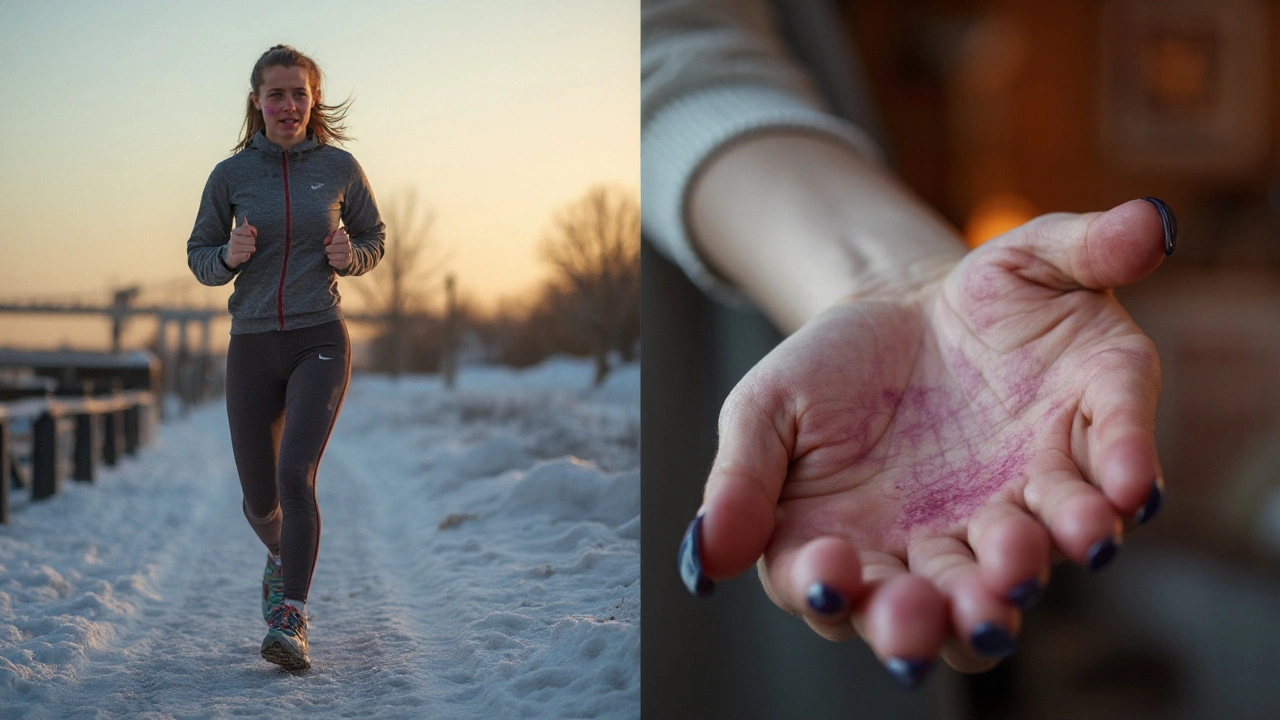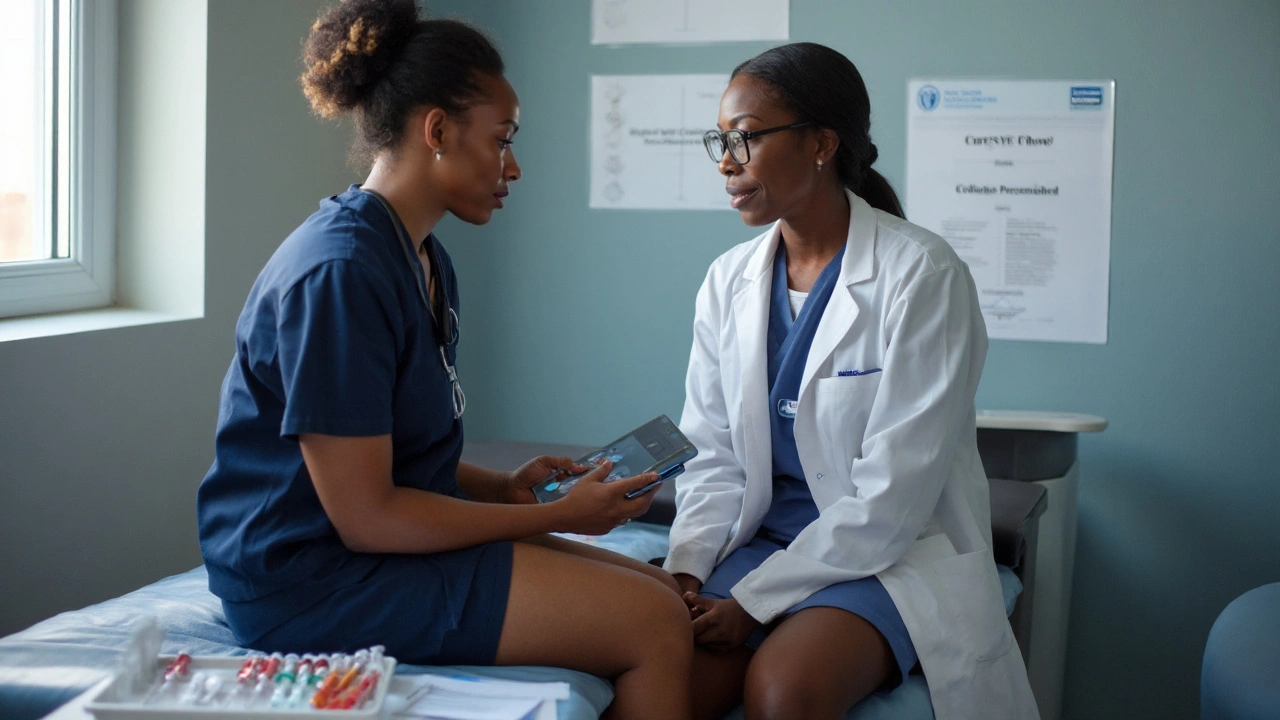 Sep, 1 2025
Sep, 1 2025
A purple, net-like pattern across your legs after a cold walk can be harmless. It can also be the first clue to an autoimmune problem affecting your blood vessels. If you’re staring at your skin and wondering which it is, you’re in the right place. I’ll keep this plain, practical, and focused on what actually helps you decide what to do next.
TL;DR
- Cold-related mottling that fades with warmth is common and usually benign; persistent or painful patterns deserve a medical check.
- Livedo reticularis/livedo racemosa can signal autoimmune issues like antiphospholipid syndrome (APS), lupus, vasculitis, or cryoglobulinemia.
- Red flags: fixed or branching pattern, ulcers, numb/blue toes, headaches or stroke-like symptoms, chest pain, breathlessness, fevers, miscarriages.
- First-line tests often include FBC, ESR/CRP, ANA, antiphospholipid antibodies, complements, urinalysis, thyroid tests; sometimes a skin biopsy.
- Warmth, smoking cessation, and medication review help now; see your GP for referral to dermatology/rheumatology if features are persistent or systemic.
What mottled skin means and how autoimmune diseases create it
People often call it “mottling,” “marbling,” or a “lace-like” pattern. Clinicians use a few labels:
- Cutis marmorata: a pink-purple net that appears in cold and fades when warm. Common in infants and thin-skinned adults. Usually harmless.
- Livedo reticularis: a more persistent, net-like pattern caused by changes in blood flow in small vessels. Can be physiological (cold) or pathological (disease-related).
- Livedo racemosa: broken, irregular, branching patches. More strongly linked with underlying disease, especially medium-vessel problems and clotting disorders.
Why the pattern? Think plumbing. Skin blood vessels open and close to conserve heat. When they constrict unevenly or get blocked, blood pools in a net-like layout. Harmless cold constriction clears with warmth. Disease-driven changes don’t clear so easily, especially if there’s inflammation of vessels (vasculitis) or a tendency to clot (hypercoagulable states).
Autoimmune links that matter:
- Antiphospholipid syndrome (APS): causes clots in arteries and veins, miscarriages, migraines, and livedo. The livedo often looks broken/branching (racemosa). (EULAR recommendations, 2019; updated guidance 2023)
- Systemic lupus erythematosus (SLE): can affect vessels, clotting, and complements; livedo can show up with other signs like joint pain, mouth ulcers, photosensitivity. (ACR/EULAR classification criteria, 2019/2023)
- Vasculitides: inflammation of vessel walls (e.g., ANCA-associated vasculitis, polyarteritis nodosa) can reduce blood flow, causing livedo, tender nodules, ulcers, or nerve symptoms. (British Society for Rheumatology guidance, 2022)
- Cryoglobulinemia and cold agglutinin disease: immune proteins clump in cold, impairing flow; livedo, purpura, Raynaud’s, and neuropathy are common. Often linked with hepatitis C or other triggers. (BMJ Best Practice, 2024)
- Dermatomyositis and other connective tissue diseases: can change capillaries and medium vessels, causing mottling along with muscle weakness or nailfold changes. (BAD guideline summaries, 2023)
Non-autoimmune causes to keep on the radar:
- Cold exposure and low body fat (physiological). Clears with warmth.
- Medications: amantadine (classic), minocycline, catecholamines, some chemo. The pattern fades after stopping the drug, but slowly. (JAMA Dermatology review, 2020)
- Cholesterol emboli (usually older adults after vascular procedures), severe infections, or shock states. These come with systemic illness and pain. (NEJM clinical reviews)
- Raynaud’s phenomenon: fingers/toes blanch, then blue/purple, then red with rewarming. Can coexist with mottling.
Simple rule of thumb: if the pattern is new, fixed, painful, branching, or paired with other symptoms (ulcers, headaches, miscarriages, breathlessness), get it checked. If it pops up on cold Bristol mornings and goes away once you’re warm, it’s likely benign.
| Pattern | Typical features | What it suggests | Action |
|---|---|---|---|
| Cutis marmorata | Symmetric, pink-purple net after cold; fades in minutes | Physiological response | Warm up; monitor |
| Livedo reticularis | Persistent net; may darken in cold; can be tender | May be disease-related | See GP if persistent, painful, or with other symptoms |
| Livedo racemosa | Broken, branching, irregular patches | Strong link to APS/vasculopathy | Medical review; likely blood tests ± imaging/biopsy |
| Raynaud’s | Color changes in digits (white-blue-red), numb/painful | Vasospasm ± connective tissue disease | Keep warm; discuss vasodilators if severe |
| Vasculitis | Painful skin, purpura, nodules/ulcers, systemic symptoms | Inflamed vessels (small/medium) | Urgent assessment and labs |
Evidence note: the British Association of Dermatologists and Dermatology textbooks describe livedo patterns much like this, and a 2020 JAMA Dermatology review places APS and medium-vessel disease at the center of livedo racemosa. NICE Clinical Knowledge Summaries for Raynaud’s (2024 update) guide first-line management and red flags in primary care.

How to tell harmless mottling from warning signs
Use the “warmth test.” If the net fades within 10-15 minutes of warming up (bath, heated room, trousers), that leans benign. If it sticks around for hours, looks broken and branchy, or hurts, book a GP appointment.
Quick home check (5 minutes):
- Onset: When did you first notice it? Sudden onset in one limb is more concerning than a gradual, symmetric pattern on both thighs.
- Trigger: Does cold, stress, or standing bring it on? Does warmth reliably clear it?
- Distribution: Legs and thighs are common. Involvement of arms, trunk, or buttocks can happen; asymmetry or one cold, pale foot is a worry.
- Texture: Any tenderness, nodules, or ulcers? Ulcers or pain suggest vessel disease.
- Other symptoms: Headache, visual changes, slurred speech, chest pain, breathlessness, blue toes, pins and needles, night sweats, fevers, weight loss, miscarriages.
Red flags that need urgent care:
- Stroke-like symptoms (face droop, arm weakness, speech trouble) with new livedo - call emergency services immediately.
- Chest pain, sudden breathlessness, or coughing blood.
- A cold, painful, pale or blue limb; rapidly spreading bruising/purple patches with fever.
- Painful skin nodules, ulcers, or blackened areas.
Common lookalikes and how to separate them:
- Physiological mottling vs disease: disappearing with warmth vs fixed; no pain vs tender; no systemic signs vs joint pain, headaches, or ulcers.
- Raynaud’s vs livedo: Raynaud’s hits fingers/toes with clear color phases; livedo is a network pattern on broader skin areas.
- Bruising vs livedo: bruises change color over days and are patchy; livedo is net-like and follows vascular patterns.
Everyday heuristics that help:
- If it’s new + persistent + painful = see a clinician.
- If it’s cold-triggered + symmetric + clears fast = likely benign, keep an eye on it.
- If it’s branching + irregular + you’ve had miscarriages or clots = ask about antiphospholipid testing.
Document it like a pro (you’ll help your doctor):
- Take clear photos in daylight with something for scale (e.g., a coin). Do one when it’s prominent and one after warming for 15 minutes.
- Note room/outdoor temperature, how long it took to appear/disappear, and any triggers (shower, run, stress).
- List symptoms and timelines: headaches, joint pains, sores, miscarriages, meds started in the last 6-12 months.
I do this in my notes app while Marbles, my cat, steals the warm spot on the sofa. It’s simple, and it prevents forgetting the important details at the appointment.

Diagnosis, treatment, and next steps
Who to see in the UK: start with your GP. They can check red flags, run first-line tests, and refer to dermatology or rheumatology if the pattern or symptoms suggest an underlying disorder.
What tests are commonly ordered (your GP will decide based on your story and exam):
- Basic bloods: full blood count, ESR/CRP (inflammation), kidney and liver function, fasting lipids, glucose.
- Autoimmune screen: ANA; if positive, ENA panel, dsDNA, complements (C3/C4); rheumatoid factor/CCP if joint features.
- Clotting/vasculopathy: antiphospholipid antibodies - lupus anticoagulant, anticardiolipin, beta-2 glycoprotein I; clotting screen; sometimes D-dimer.
- Cold-related proteins: cryoglobulins; cold agglutinin testing if hemolysis suspected.
- Infectious triggers: hepatitis C and B if cryoglobulinemia/PAN suspected.
- Thyroid function (hypothyroidism can worsen cold-induced changes).
- Urinalysis for blood/protein (kidney involvement in lupus/vasculitis).
- Imaging: Doppler ultrasound if limb blood flow is a worry; MRI/MRA if neurologic symptoms suggest vessel disease.
- Skin biopsy: a punch or deep incisional biopsy from active areas can show vessel changes (thrombi, vasculitis, occlusion). Dermatology decides timing and site. (BAD procedural guidance, 2023)
Treatment depends on the cause:
- Physiological mottling: warmth, layers, movement, and reassurance.
- Drug-induced livedo: discuss stopping the culprit (amantadine is a frequent offender); the pattern can take months to fade. Never stop a prescription without medical advice.
- Raynaud’s: thermal protection, smoking cessation, stress management; medications like nifedipine or amlodipine for severe cases; topical nitroglycerin sometimes used. (NICE CKS Raynaud’s, 2024)
- APS or clotting tendency: antiplatelets or anticoagulation per risk profile; specialist-led. Pregnancy planning is key. (EULAR APS guidance, 2019/2023)
- Vasculitis: immunosuppression guided by type/severity - steroids initially, then agents like azathioprine, methotrexate, mycophenolate, cyclophosphamide, or rituximab. (BSR vasculitis guideline, 2022)
- Cryoglobulinemia: treat the driver (e.g., antivirals for hepatitis C); warmth and vascular protection; immunotherapy if severe.
- Lupus/CTDs: tailored immunomodulators; treat skin and systemic disease together.
What you can do today while waiting for an appointment:
- Warmth strategy: wear thermal layers, warm tights/leggings, keep your core warm, use hand/foot warmers on cold days.
- Move more, sit less: gentle walking or calf raises every 30-60 minutes to improve flow.
- Hydrate and moisturise: good emollients support skin barrier; dehydration and wind make symptoms look worse.
- Check medications: note any recent starts (amantadine, minocycline, stimulants) to discuss with your GP.
- Stop smoking/vaping nicotine: nicotine constricts vessels and worsens mottling and Raynaud’s. Support services on the NHS can help.
- Protect your skin: avoid tight bands/socks that leave deep marks; consider light compression only if advised.
Appointment checklist (bring this to your GP):
- Photos of the pattern (prominent and after warming), with dates/times.
- Symptom timeline: when it started, triggers, what helps, associated symptoms.
- Personal/family history: clots, miscarriages, autoimmune diseases, migraines, thyroid issues.
- Medication and supplement list, including start dates.
- Questions you want answered (e.g., “Could this be APS?” “Do I need a biopsy?”).
Pro tips from clinic experience and UK guidance:
- If you’re planning pregnancy and have persistent livedo plus a history of miscarriages, ask about antiphospholipid testing before conceiving. (RCOG and EULAR recommendations)
- Branching, irregular livedo that includes the thighs and buttocks is more predictive of disease than a neat, even net on the shins. (JAMA Dermatology, 2020)
- Don’t rely on a single negative test for APS. Antiphospholipid antibodies may need repeat testing 12 weeks apart to confirm persistence. (EULAR)
- Biopsy accuracy goes up when taken from an active, fresh lesion and deep enough to sample medium vessels. Dermatology will choose the site. (BAD biopsy guidance)
Mini‑FAQ
Is mottled skin always autoimmune? No. The majority I see in primary care is cold-related and benign. Persistence, pain, branching, or systemic symptoms push it into “needs workup.”
Can COVID-19 cause these patterns? Severe COVID has been linked to vascular skin signs, including livedo, due to microthrombi. In everyday life now, persistent livedo still deserves the usual workup. (Lancet Dermatology commentary, 2021-2022)
Could exercise cause it? Hard effort in cold weather can bring out physiologic mottling. If it fades with warmth and rest, that’s reassuring.
What about children? Babies often show cutis marmorata that fades with warmth and age. Persistent, painful, or ulcerating patterns in children should be assessed.
Does sunlight help? Tans can mask the pattern but don’t treat the cause. Prioritise warmth and vessel health; use sunscreen to protect the skin barrier.
Any supplements? Some people try omega‑3s for vascular health. Evidence is limited for livedo. Discuss with your GP, especially if you’re on blood thinners.
Could this be from my meds? Amantadine is well known for causing livedo; minocycline and some stimulants can contribute. Bring your medication list to your GP to review risks and alternatives.
Next steps / Troubleshooting
- If it fades with warmth and you feel well: keep a photo diary for two weeks, optimise warmth and hydration, and monitor. If it persists or worsens, book a GP appointment.
- If it’s persistent without pain but you have autoimmune history: book a non-urgent GP appointment for baseline tests (ANA, antiphospholipid panel, complements).
- If it’s painful, branching, or with ulcers: book a prompt GP appointment; expect referral to dermatology/rheumatology and possible biopsy.
- If you have stroke-like symptoms or chest pain/breathlessness: treat it as an emergency.
- Pregnancy or planning pregnancy with livedo and past miscarriages: ask for antiphospholipid testing and pre-conception counselling.
One last practical filter you can use right now: place a warm compress over a clear, photographed patch for 10 minutes. If the net pattern remains almost unchanged, especially if it’s irregular or tender, you’ve earned a medical review. If it melts away and your legs feel fine, stick with warmth, movement, and smoke‑free habits - and keep your photo diary handy just in case.
Key sources that inform this guide: British Association of Dermatologists guidance on livedo and skin biopsy technique (2023); EULAR recommendations for antiphospholipid syndrome (2019; updates through 2023); ACR/EULAR lupus classification criteria (2019/2023); British Society for Rheumatology vasculitis guidelines (2022); NICE Clinical Knowledge Summaries on Raynaud’s (2024 update); and a JAMA Dermatology review on livedo patterns and causes (2020). These reflect how UK clinicians approach assessment and management in 2025.
If you only remember one phrase, make it this: persistent, branching, painful mottled skin discoloration - especially with other symptoms - is a nudge to see your GP and ask about clotting and vessel tests.
Declan Flynn Fitness
September 6, 2025 AT 19:20Been seeing this exact pattern on my legs after winter runs for years - always thought it was just cold blood flow. Your warmth test tip is gold. Took a pic last week after a 10°C run, warmed up for 15 mins, and the net vanished. No more panic mode. Thanks for the clarity.
Michelle Smyth
September 8, 2025 AT 06:28How delightfully reductive. You've reduced the phenomenological experience of vascular dysregulation - a profound ontological rupture in the body's thermoregulatory phenomenology - to a checklist. The livedo is not a symptom. It is a hermeneutic event. A silent scream of endothelial alienation. You offer diagnostics, but where is the *poetics* of the marbling? Where is the mourning for the body's forgotten language?
Patrick Smyth
September 8, 2025 AT 11:05I’ve had this for 7 years and no doctor ever said a word. My wife made me go last month. Turns out I’ve got APS. I’ve had three miscarriages. I didn’t even know. You just saved my life. Thank you.
Bee Floyd
September 8, 2025 AT 20:42Love how you broke this down like a field guide for the body’s secret language. I took your advice and snapped photos before and after my shower - the difference was night and day. Also, I quit vaping last week. My legs already feel less… angry. Small wins, right?
Jeremy Butler
September 8, 2025 AT 23:45While the empirical utility of the proposed diagnostic algorithm is undeniably pragmatic, one must interrogate the epistemological foundations upon which the distinction between physiological and pathological livedo is predicated. The binary categorization presupposes a Cartesian dichotomy between ‘normal’ and ‘pathological’ bodily states - a framework increasingly challenged by post-structuralist medical anthropology. The skin, as a topological interface, does not merely reflect pathology; it enacts it.
Souvik Datta
September 9, 2025 AT 17:04Bro, this is the kind of info that should be on every Indian family WhatsApp group. My aunt had this for years, thought it was just ‘bad circulation.’ Turned out she had lupus. I’m sharing this with my whole village. Also - warm socks, not hot water bottles. Trust me, learned the hard way.
Priyam Tomar
September 10, 2025 AT 18:44Typical Western medical reductionism. You ignore the real cause: 5G radiation messing with your capillaries. Also, your ‘warmth test’ is a placebo trick. Real healers use copper bracelets and moon-charged rose quartz. And stop eating gluten - it’s the root of all vascular decay. You’re all being manipulated by Big Pharma.
Walker Alvey
September 11, 2025 AT 07:33Wow. A whole 2000-word essay on how to not freeze your legs. Did you get a PhD in ‘Warm Leg Management’? Congrats. I’m sure the NIH is weeping with joy.
Louise Girvan
September 12, 2025 AT 15:08They’re lying. This isn’t autoimmune - it’s the microchips in your vaccines. They’re tracking you through your skin. That’s why it only shows up after you’ve been outside. And the ‘tests’? They’re just scanning your blood for the signal. Don’t go to the doctor. Burn your photos. And stop using your phone.
Declan Flynn Fitness
September 13, 2025 AT 16:19Hey @PatrickSmyth - I’m so sorry you went through that. You’re not alone. I had the same thing - didn’t connect the dots until I lost my mom to a stroke. Your story is why stuff like this matters. Keep advocating. And congrats on getting help. You’re gonna be okay.